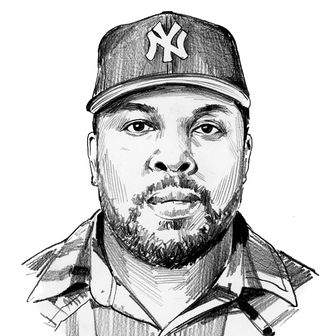
Rock and roll never really dies. It flowers, and it withers. In its fertile periods, rock is fuel feeding cultural change. The darlings of the ’60s counterculture used electric guitars to infuse their struggles with the sweat and fury of the blues. Punk rock anthropomorphized ’70s fatalism in guttural tunes that raced to explosive climaxes. And ’80s singer-songwriters sold populist calls for prosperity through stately, unvarnished pub rock that embraced the tastes of the working-class people it lifted up as heroes in its lyrics. In its fallow periods, rock is bloated and high on the hog, lounging cozily in the commerce corner of the tug-of-war between mainstream music’s commercial and creative interests. Think of the end of the ’70s, when aging rockers cooked up awkward experiments in disco, New Wave, and easy listening to cash in on burgeoning trends, or the ends of the hair-metal boom of the ’80s and the alternative-rock gold rush of the ’90s, when a stream of designer knockoffs of the eras’ biggest artists diluted the potency of both scenes. Advances in rock and roll come in spurts; sometimes it lurches into the future with style and purpose, and sometimes it thrashes around, treading water until the next wave hits.
This year, rock and roll seems bored with itself. The most successful acts of the past few years have been bands bristling at the boundaries of the guitar, bass, and drums setup. The genre’s best-selling album of 2018 was Las Vegas electro-rockers Imagine Dragons’ summer 2017 full-length Evolve, a work that prefers humming synths and suspenseful atmospherics to the growl of a six-string. The decade-long ascent of Imagine Dragons — which began in earnest when singer-songwriter Dan Reynolds met his bandmates at the strict, parochial Brigham Young University and went supernova when the band performed “Radioactive,” the single from its debut album Night Visions, at the 2014 Grammys alongside Interscope labelmate Kendrick Lamar — has looked like a mandate on the future of popular guitar music. Imagine Dragons grew by rooting itself in the throbbing pulse of electronic music, the same way its hometown precursor the Killers did in the 2000s, but lacking front man Brandon Flowers’s Springsteenian ambitions as a guitar-wielding poet of the Everyman, Reynolds seems built to last longer at pop music’s center. Where Imagine Dragons went, a generation of veteran rock outfits has followed.
In January, Fall Out Boy advanced Pete Wentz and Patrick Stump’s trek from mall emo kings to weight-room staples with the cold dance-pop cash-out M A N I A. In March, Strokes singer Julian Casablancas’s side project the Voidz released the smart, mercurial Virtue, which pump-faked listeners at the gate with the immaculate Strokes-lite tune “Leave It in My Dreams” and then spun off into trip-hop, chillwave, and parts unknown. Jack White’s Boarding House Reach augmented the former White Stripes leader’s garage-rock excellence with buzzing keyboards and quirky experiments in hip-hop. In April, actor Jared Leto’s Thirty Seconds to Mars turned a corner in its 15-year history of temperamental post-hardcore with America, a messy concept record whose single “Walk on Water” sounded like an exercise in composing a blues-rock tune without any of the blues or the rock. Vegas emo outfit Panic! at the Disco reconvened as singer-songwriter Brendon Urie’s own one-man band for this summer’s Pray for the Wicked, a colorful mélange of pop, EDM, and hip-hop whose single “High Hopes” — a pep-rally anthem with a brass fanfare from the same cloth as Beyoncé’s “Countdown” or Kanye West’s “All of the Lights” — is Panic!’s biggest hit to date. In October, Ohio duo Twenty One Pilots built on the worldwide success of its 2015 album Blurryface with the ambitious, occasionally quite good pop/rock/reggae/rap fusion album Trench. M A N I A, Boarding House Reach, America, and Pray for the Wicked all debuted at No. 1 on the Billboard 200 chart.
Part of the story here is bands getting wise to the dominance of rap and EDM and glomming on to trends to stay afloat. That makes the rock scene look a lot like the ’80s, when veterans from the ’60s and ’70s held court with younger music fans by trying on the jerky, synthetic production values of the era. But half the reason Fall Out Boy and Imagine Dragons have skipped across genres at no cost to their success in the last decade is that the ease of access to music afforded by piracy and later by streaming made listeners less fussy. Eventually, tastes became more expansive. Open borders bred new and unusual hybridizations. Manchester, England’s the 1975 — whose latest album A Brief Inquiry Into Online Relationships mixed and matched aspects of rock, synth-pop, jazz, and trap as one assembles outfits in a department-store fitting room — has gained popularity in the U.S. and the U.K. because its music resembles the unpredictable shiftlessness of a playlist. Lead singer Matty Healy doesn’t even like to hear the 1975 referred to as a rock band. “To try to understand things by slapping an ideology on it is an old-fashioned method,” Healy told The Fader last month when asked about his and Imagine Dragons’s slippery union of rock and dance music. “If you’re bred through the internet, you’re bred with zero tribalism.”
Twenty eighteen is a peculiar moment in the history of rock because while the biggest bands of the moment seem allergic to the sound of the electric guitar, and even to the very concept of a rock band, the public still hungers for the stuff. This fall, director Bryan Singer and actor Rami Malek’s Freddie Mercury biopic Bohemian Rhapsody surpassed 2015’s N.W.A. flick Straight Outta Compton, claiming the title of the best-selling music biopic of all time in its first month out. Fascination with Rhapsody and Queen kept the film’s soundtrack, as well as Queen’s 1981 Greatest Hits album and its 2000 Platinum Collection, which compiles Hits and its 1991 and 1999 sequels, active enough in sales and streams to place among the year’s best-selling rock albums. (Queen classics currently account for a third of the Hot Rock Songs chart.) Other successful back catalogue staples this year include hits comps from Tom Petty, who passed away last October, and Elton John, whose Farewell Yellow Brick Road tour kicked off in September, and whose forthcoming biopic Rocketman seems destined for the same breakout success as the Queen film.
Nostalgia’s a powerful force in rock and roll, especially now, as a new generation of bands, and by extension, their fans, are entering classic-rock radio rotation. (New York’s classic-rock station Q104.3 has been creaming the rap stations Hot 97 and Power 105.1 in overall ratings for months, in spite of Hot and Power’s year of attention-grabbing interviews and Nielsen analysts’ declaration that hip-hop has eclipsed rock as the nation’s favorite genre of music.) The success of Anthem for the Peaceful Army, the debut album by the Michigan band Greta Van Fleet, is a symptom of a rock scene haunted by its own Ghost of Christmas Past. Singer Josh Kiszka’s sharp, fey vocal is a tribute to warbling mystics like Geddy Lee from Rush and Led Zeppelin’s Robert Plant. Anthem found Greta twisting Zeppelin’s trademark hard-rock stomp into new forms with the same balance of recklessness and devotion as fan fiction. Anthem is spirited but almost inexcusably unoriginal. Even so, Robert Plant seems amused, and Slash from Guns N’ Roses says Greta is “the future of rock and roll.” Critics have suggested that Anthem’s traction speaks to a music industry powered by streaming services’ “recommended if you like” algorithms, but that doesn’t quite cover it. Some 80,000 of the 87,000 equivalent units the album pushed in its first week to claim the No. 3 spot on the Billboard 200 chart were pure sales. Greta’s Spotify play counts are good but not gobstopping. The band doesn’t appear anywhere in Billboard’s list of the year’s top 50 most streamed rock songs at all.
Although they might not be the central forces fueling Greta Van Fleet’s fire, playlist placement and streaming service algorithms are still having a profound effect on the direction of modern rock music. A service built around shuffling listeners through like-minded artists can be a closed loop; a playlist whose success hinges on people sticking it out ends up beholden to the same attention games as radio. In the same way that Spotify’s dedicated new hip-hop playlist Rap Caviar skews toward male major-label trap artists, Spotify new-rock playlists like Rock This and the New Alt are boys’ clubs that disproportionately feature men making mainstream and mainstream-adjacent pop rock. Cook up a single that works on a rock playlist, a pop playlist, and a workout playlist — a feat Imagine Dragons has repeated consistently over the last five years — and you triple your exposure. It’s presumptuous to suggest that this is the secret motivation for the sea change in mainstream rock, but it’s foolhardy to believe that a system that can be gamed isn’t being gamed. Spotify takes listeners as deep as they’re willing to dive; creativity breeds more creativity, and passivity breeds more passivity. In that respect, digital music’s new boss is just the same as the old boss.
The rule of Imagine Dragons and similar motivational jock-rock purveyors on charts, radio, and streaming services is an understandable side effect of a decade of mediums and genres crashing and folding into new forms, but the proliferation of music that bears a closer resemblance to synth-pop than guitar rock is stifling the growth of great rock acts further downstream who deserve consideration in the same spaces. Twenty eighteen was a great year for all the guitar-based musical traditions. Hard-core bands like Vein, Turnstile, and the Armed released searing works that deconstructed the idea of what the music should sound like. Mitski, Soccer Mommy, Snail Mail, and Lucy Dacus all crafted breathtaking full lengths that brought the tart three-chord hooks of alternative rock’s past screaming into the present, but if you didn’t have a reliable blog or a friend in the know steering you toward them, they were easy to miss (unless you happened upon Spotify’s shockingly airtight Hanging Out and Relaxing playlist). How does rock find its future if the artists doing the brightest, weirdest work remain in the margins? Can algorithms be benevolent? How much more do Twenty One Pilots, Fall Out Boy, and Imagine Dragons have left in the tank, when Trench, M A N I A, and Origins are all struggling to match the platinum certifications of their predecessors? Is the tide already turning again?





